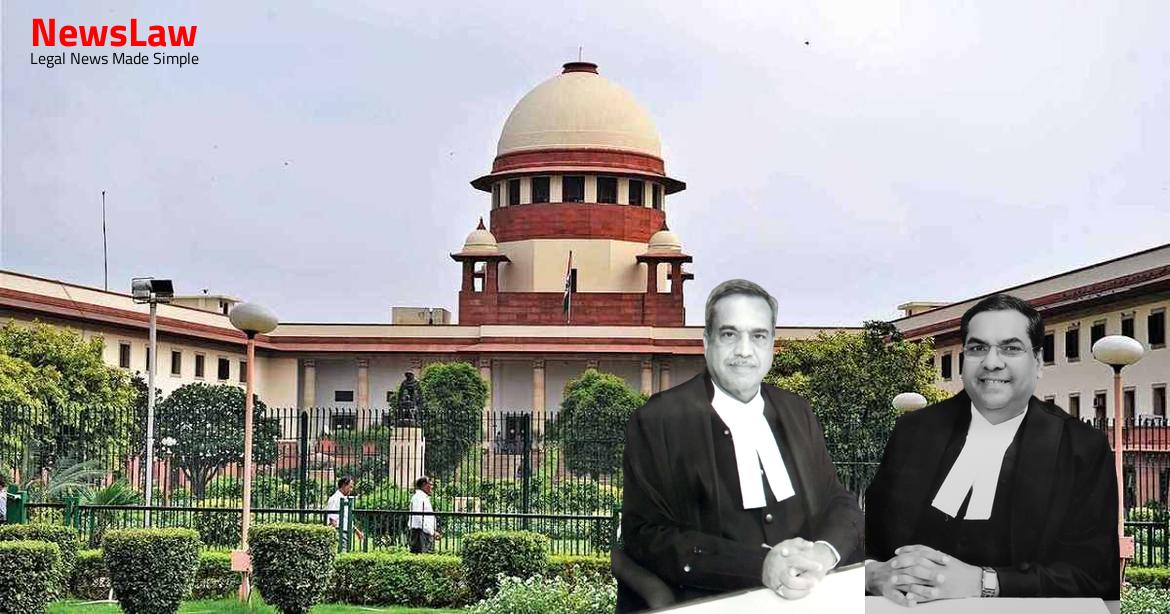Delve into the complexities of concurrent sentencing in the context of drug trafficking cases. The court’s detailed legal analysis on the application of Section 427 of Cr.PC provides insights into how sentences are determined for offenders involved in multiple drug-related offences. Understanding the nuances of concurrent sentences is crucial in ensuring justice is served effectively in such cases.
Facts
- The appellant faced trial in connection with FIR No.134/1999 for the offence under Section 23 and Section 21 of the NDPS Act, PS Customs, Amritsar, Punjab for recovery of 4 kg of heroin and was sentenced to undergo 12 years RI by the Amritsar Court.
- Another FIR was filed against the appellant being FIR No.43/1999 at New Delhi for the recovery of 750 grams of heroin from Delhi.
- The sentence ordered by the Court was rigorous imprisonment of 16 years. The Trial Court in Delhi imposed a sentence of 10 years RI (minimum sentence) but enhanced it to 15 years under Section 31 (ii) of the NDPS Act due to previous conviction.
- The sentence would run concurrently for both cases, and a fine of Rs. 1 lakh imposed by the Trial Court in Gujarat remained.
- In the second case, the appellant was held guilty under Section 29 read with Section 21(c) of the NDPS Act.
- The High Court dismissed the appeal of the appellant challenging the judgment and order of conviction and confirmed the sentence, reducing the fine to Rs. 5 lakhs.
- The appellant’s Special Leave Petition was dismissed by the Supreme Court, making the conviction and sentence final.
- The appeals were disposed of as per the previous judgment.
- The accused has now filed the current appeal.
Also Read: Upholding Professional Standards in Legal Disciplinary Proceedings
Arguments
- The appellant faced two separate trials for two separate offences and transactions.
- The sentencing court did not direct the sentences to run concurrently.
- In one case, the sentence was 15 years RI without specifying concurrent or consecutive terms.
- If the sentences are not held to run concurrently, the appellant would have to serve a total of 27 years imprisonment.
- The appellant has already served 12 years RI in one case.
- The discretion under Section 427 of Cr.PC for concurrent sentences should consider the nature of the offences and the facts of the case.
- The appellant’s good conduct in jail with no adverse remarks by the Jail Superintendent is highlighted.
- Several court decisions are cited to support the argument for concurrent sentences.
- The appellant, a foreign national from Pakistan, has been in prison for almost 22 years.
- The argument for the appellant to be given the benefit of Section 427 of Cr.PC is presented.
- The State argues that sentences in separate trials for different offences generally run consecutively unless specified otherwise.
- Exceptions to consecutive sentences are explained.
- The appellant’s age at the time of conviction and the current age are mentioned as factors to consider for concurrent sentencing.
- The appellant-accused has been convicted for possession/recovery of 4 kg of heroin in connection with FIR No.134/1999.
- He has also been convicted for the recovery of 750 grams of heroin in a separate case arising from FIR No.43/1999.
- The appellant-accused is considered a habitual offender based on the above mentioned convictions.
- Due to the seriousness of the offences and the appellant’s history as a habitual offender, leniency is not warranted in this case.
Also Read: Quashing of Criminal Proceedings: Legal Analysis
Analysis
- Discretion under Section 427 of Cr.PC should not favor accused involved in illegal drug trafficking.
- Illegal drug trafficking has a harmful impact on society.
- The court has the discretion to issue directions under Section 427(1) of Cr.PC, but it should be done judiciously.
- The court can decide if subsequent sentences should run concurrently based on the nature of the offenses.
- In cases involving NDPS Act, the interest of society must be considered while awarding sentences.
- Concurrent sentences can be allowed only in specific cases based on the facts.
- Sentences cannot run concurrently unless specifically ordered by the court.
- The court must consider all relevant factors before issuing directions on concurrent sentences.
- When a person already undergoing a sentence of imprisonment is sentenced on a subsequent conviction to imprisonment or imprisonment for life, the subsequent sentence shall commence at the expiration of the previous imprisonment unless directed otherwise by the Court.
- If a person sentenced to imprisonment by an order under section 122 is later sentenced to imprisonment for an offense committed prior to the order, the latter sentence shall commence immediately.
- If a person already undergoing a sentence of imprisonment for life receives a subsequent sentence of imprisonment, the subsequent sentence shall run concurrently with the previous life sentence.
- In the case of Sharad Hiru Kolambe, it was held that punishments for two or more offenses should run consecutively unless directed by the court otherwise.
- For a person already undergoing a sentence who is later imposed a sentence in respect of a subsequent trial, the general rule is that the subsequent sentence should run consecutively unless directed by the court exercising discretion under Section 427 of Cr.PC for concurrent running of sentences.
- In the case of Mohd. Akhtar Hussain, it was observed that if the transactions or facts constituting the offenses are different, subsequent sentences should run consecutively, reflecting the legislative policy for sentences to be done consecutively.
- The issue of directing concurrent running of sentences under Section 427(1) depends on the nature of the offenses committed and the specific circumstances of the case.
- Neera Yadav’s case highlighted that Section 427 of Cr.PC gives discretionary power to the court to order concurrent sentences, with sub-section (2) dealing with offenders already sentenced to life imprisonment.
- Gopal Vinayak Godse’s case established that imprisonment for life means serving the remainder of life unless commuted or remitted, which affects the running of subsequent sentences without a specific court direction.
- The court in V.K. Bansal case discussed the general rule under Section 427(1) of CrPC, with exceptions under the proviso to sub-section (1), sub-section (2), or when the court directs concurrent running of sentences.
- The Gulam Mohammad Malik case dealt with concurrent sentences under NDPS Act, emphasizing that no single consideration determines the proper sentence.
- Ranjit Singh’s case explained the provisions of sub-section (1) of Section 427 CrPC for offenders undergoing a fixed term of imprisonment and subsequent convictions to fixed term or life imprisonment.
- The discretion left to sentencing courts should not be restricted only to the seriousness of the offense, as observed in the Mohd. Akhtar Hussain case.
- Offences under the NDPS Act are very serious and against the society at large.
- No discretion shall be exercised in favor of accused indulging in NDPS Act offences.
- Subsequent sentence in a case arising from FIR No.43/1999 will not run concurrently with previous sentence from FIR No.134/1999.
Also Read: Curbing Fraudulent Claims: Court’s Legal Analysis
Decision
- The present appeal is dismissed
- The appeal fails for the reasons stated above
- The appeal deserves to be dismissed and is accordingly dismissed
Case Title: MOHD ZAHID Vs. STATE, THROUGH NCB (2021 INSC 834)
Case Number: Crl.A. No.-001457-001457 / 2021



